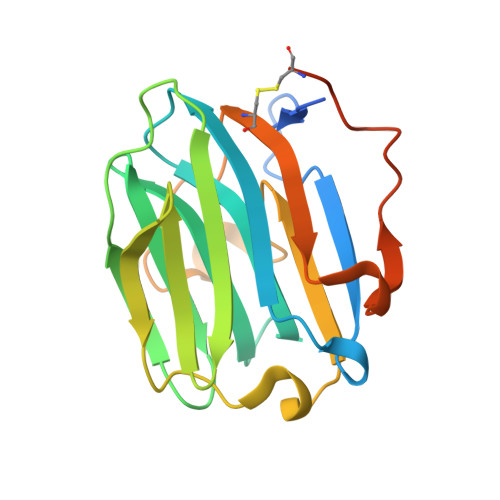Molecular interactions between sex hormone-binding globulin and nonsteroidal ligands that enhance androgen activity.
Round, P., Das, S., Wu, T.S., Wahala, K., Van Petegem, F., Hammond, G.L.(2020) J Biol Chem 295: 1202-1211
- PubMed: 31852737
- DOI: https://doi.org/10.1074/jbc.RA119.011051
- Primary Citation of Related Structures:
6PYA, 6PYB, 6PYF - PubMed Abstract:
Sex hormone-binding globulin (SHBG) determines the equilibrium between free and protein-bound androgens and estrogens in the blood and regulates their access to target tissues. Using crystallographic approaches and radiolabeled competitive binding-capacity assays, we report here how two nonsteroidal compounds bind to human SHBG, and how they influence androgen activity in cell culture. We found that one of these compounds, (-)3,4-divanillyltetrahydrofuran (DVT), present in stinging nettle root extracts and used as a nutraceutical, binds SHBG with relatively low affinity. By contrast, a synthetic compound, 3-(1H-imidazol-1-ylmethyl)-2phenyl-1H-indole (IPI), bound SHBG with an affinity similar to that of testosterone and estradiol. Crystal structures of SHBG in complex with DVT or IPI at 1.71-1.80 Å resolutions revealed their unique orientations in the SHBG ligand-binding pocket and suggested opportunities for the design of other nonsteroidal ligands of SHBG. As observed for estradiol but not testosterone, IPI binding to SHBG was reduced by ∼20-fold in the presence of zinc, whereas DVT binding was almost completely lost. Estradiol-dependent fibulin-2 interactions with SHBG similarly occurred for IPI-bound SHBG, but not with DVT-bound SHBG. Both DVT and IPI increased the activity of testosterone in a cell culture androgen reporter system by competitively displacing testosterone from SHBG. These findings indicate how nonsteroidal ligands of SHBG maybe designed to modulate the bioavailability of sex steroids.
Organizational Affiliation:
Department of Cellular & Physiological Sciences, The University of British Columbia, Vancouver, BC Canada V6T 1Z4.
















